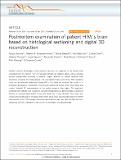| dc.contributor.author | Annese, Jacopo | |
| dc.contributor.author | Schenker-Ahmed, Natalie M. | |
| dc.contributor.author | Bartsch, Hauke | |
| dc.contributor.author | Maechler, Paul | |
| dc.contributor.author | Sheh, Colleen | |
| dc.contributor.author | Thomas, Natasha | |
| dc.contributor.author | Kayano, Junya | |
| dc.contributor.author | Ghatan, Alexander | |
| dc.contributor.author | Bresler, Noah | |
| dc.contributor.author | Frosch, Matthew P. | |
| dc.contributor.author | Klaming, Ruth | |
| dc.contributor.author | Corkin, Suzanne Hammond | |
| dc.date.accessioned | 2015-04-24T13:19:33Z | |
| dc.date.available | 2015-04-24T13:19:33Z | |
| dc.date.issued | 2014-01 | |
| dc.date.submitted | 2013-10 | |
| dc.identifier.issn | 2041-1723 | |
| dc.identifier.uri | http://hdl.handle.net/1721.1/96777 | |
| dc.description.abstract | Modern scientific knowledge of how memory functions are organized in the human brain originated from the case of Henry G. Molaison (H.M.), an epileptic patient whose amnesia ensued unexpectedly following a bilateral surgical ablation of medial temporal lobe structures, including the hippocampus. The neuroanatomical extent of the 1953 operation could not be assessed definitively during H.M.’s life. Here we describe the results of a procedure designed to reconstruct a microscopic anatomical model of the whole brain and conduct detailed 3D measurements in the medial temporal lobe region. This approach, combined with cellular-level imaging of stained histological slices, demonstrates a significant amount of residual hippocampal tissue with distinctive cytoarchitecture. Our study also reveals diffuse pathology in the deep white matter and a small, circumscribed lesion in the left orbitofrontal cortex. The findings constitute new evidence that may help elucidate the consequences of H.M.’s operation in the context of the brain’s overall pathology. | en_US |
| dc.description.sponsorship | National Science Foundation (U.S.) (Grant SGER 0714660) | en_US |
| dc.description.sponsorship | Charles A. Dana Foundation (Brain and Immuno-Imaging Award 2007-4234) | en_US |
| dc.language.iso | en_US | |
| dc.publisher | Nature Publishing Group | en_US |
| dc.relation.isversionof | http://dx.doi.org/10.1038/ncomms4122 | en_US |
| dc.rights | Creative Commons Attribution | en_US |
| dc.rights.uri | http://creativecommons.org/licenses/by-nc-nd/3.0/ | en_US |
| dc.source | Nature Publishing Group | en_US |
| dc.title | Postmortem examination of patient H.M.’s brain based on histological sectioning and digital 3D reconstruction | en_US |
| dc.type | Article | en_US |
| dc.identifier.citation | Annese, Jacopo, Natalie M. Schenker-Ahmed, Hauke Bartsch, Paul Maechler, Colleen Sheh, Natasha Thomas, Junya Kayano, et al. “Postmortem Examination of Patient H.M.’s Brain Based on Histological Sectioning and Digital 3D Reconstruction.” Nature Communications 5 (January 28, 2014). | en_US |
| dc.contributor.department | Massachusetts Institute of Technology. Department of Brain and Cognitive Sciences | en_US |
| dc.contributor.mitauthor | Corkin, Suzanne Hammond | en_US |
| dc.relation.journal | Nature Communications | en_US |
| dc.eprint.version | Final published version | en_US |
| dc.type.uri | http://purl.org/eprint/type/JournalArticle | en_US |
| eprint.status | http://purl.org/eprint/status/PeerReviewed | en_US |
| dspace.orderedauthors | Annese, Jacopo; Schenker-Ahmed, Natalie M.; Bartsch, Hauke; Maechler, Paul; Sheh, Colleen; Thomas, Natasha; Kayano, Junya; Ghatan, Alexander; Bresler, Noah; Frosch, Matthew P.; Klaming, Ruth; Corkin, Suzanne | en_US |
| dc.identifier.orcid | https://orcid.org/0000-0003-1155-858X | |
| mit.license | PUBLISHER_CC | en_US |
| mit.metadata.status | Complete | |
